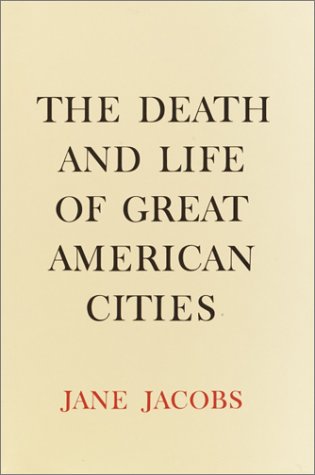The Death and Life of Great American Cities / Jane Jacobs
| List Price: | |
| Our Price: | |
|
Used Book Price: $9.40 | |
| The Death and Life of Great American Cities / Jane Jacobs | |
| Publisher: Random House | |
| Availability: | |
| Sales Rank: 2503323 | |
|
This book is an attack on current methods of city planning and re-building. It is also an explanation of new principles and an argument for different methods from those now in use. It is the first real alternative to conventional city planning that we have had in this century. Its author, herself a city dweller and an editor of Architectural Forum, is direct and practical in her approach. What, she asks, makes cities work? Why are some neighborhoods full of things to do and see and why are others dull? Why does the crime rate soar in our public housing developments and why are some of our older neighborhoods, despite their evident pov-erty, so much more safe, stable and congenial? Why do some neighborhoods attract interested and responsible populations and why do others degenerate? Why are Boston's North End and the eastern and western extremes of Greenwich Village good neighborhoods and why do orthodox city planners consider them slums? What alternatives are there to current city planning and rebuilding?
Conventional city planning holds that cities decline because they are blighted by too many people, by mixtures of commercial, industrial and residential uses, by old buildings and narrow streets and by small landholders who stand in the way of large-scale development. Such neighborhoods, they insist, breed apathy and crime, discourage investment and contaminate the areas around them. The response of con-ventional city planning is to tear them down, scatter their inhabitants, lay out super-blocks, and rebuild the area accord-ing to an integrated plan, with the result, as often as not, that the crime rate rises still higher, the new neighborhood is more lifeless than the old one, and the surrounding areas deteriorate even more, until the life of the whole city is threatened.
But Mrs. Jacobs observes that in any number of cases these very conditions--mixed uses, dense population, old buildings, small blocks, decentralized ownership--create the very opposite of slums, neighborhoods that regenerate themselves spontaneously, that are full of variety and diversity, that attract large numbers of casual visitors and responsible new residents, that encourage investment and revitalize the areas around them. Boston's North End (condemned as a slum by or-thodox planners) is such a neighborhood, and so is Greenwich Village. Rittenhouse Square and Telegraph Hill are others. Nearly every large city can produce still other examples.
Why then do some city neighborhoods die and why do others flourish? And what can city planners do to avoid the death and encourage the life of our great American cities? The solutions proposed by Mrs. Jacobs in this book represent a sharp break with conventional thinking on the subject and they carry with them the ring of simple truth which marks this book as an inevitable classic of social thought.
This edition is set from the first American edition of 1961 and commemorates the seventy-fifth anniversary of Random House.
Now you can buy Books online in USA,UK, India and more than 100 countries.
*Terms and Conditions apply
Disclaimer: All product data on this page belongs to .
.
No guarantees are made as to accuracy of prices and information.
Conventional city planning holds that cities decline because they are blighted by too many people, by mixtures of commercial, industrial and residential uses, by old buildings and narrow streets and by small landholders who stand in the way of large-scale development. Such neighborhoods, they insist, breed apathy and crime, discourage investment and contaminate the areas around them. The response of con-ventional city planning is to tear them down, scatter their inhabitants, lay out super-blocks, and rebuild the area accord-ing to an integrated plan, with the result, as often as not, that the crime rate rises still higher, the new neighborhood is more lifeless than the old one, and the surrounding areas deteriorate even more, until the life of the whole city is threatened.
But Mrs. Jacobs observes that in any number of cases these very conditions--mixed uses, dense population, old buildings, small blocks, decentralized ownership--create the very opposite of slums, neighborhoods that regenerate themselves spontaneously, that are full of variety and diversity, that attract large numbers of casual visitors and responsible new residents, that encourage investment and revitalize the areas around them. Boston's North End (condemned as a slum by or-thodox planners) is such a neighborhood, and so is Greenwich Village. Rittenhouse Square and Telegraph Hill are others. Nearly every large city can produce still other examples.
Why then do some city neighborhoods die and why do others flourish? And what can city planners do to avoid the death and encourage the life of our great American cities? The solutions proposed by Mrs. Jacobs in this book represent a sharp break with conventional thinking on the subject and they carry with them the ring of simple truth which marks this book as an inevitable classic of social thought.
This edition is set from the first American edition of 1961 and commemorates the seventy-fifth anniversary of Random House.
Now you can buy Books online in USA,UK, India and more than 100 countries.
*Terms and Conditions apply
Disclaimer: All product data on this page belongs to
 .
.No guarantees are made as to accuracy of prices and information.










